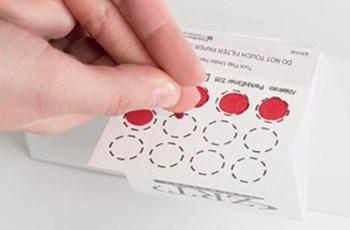
Hypothyroidism is defined as “lack of thyroid hormone production from the thyroid gland.”
However, many patients who produce sufficient hormone from the gland still suffer from low thyroid symptoms.
When thyroid levels are not within normal ranges, many conventional treatment protocols rush into thyroid replacement therapy.
Two problems exist with this approach:
- If the patient has normal levels of T4 and T3—but a slightly elevated TSH—they are classified as “Subclinical Hypothyroid” and continue to suffer from symptoms.
- If the patient has low levels of T4 and/or T3, they are given thyroid replacement therapy—even though they may produce enough thyroid hormone from their thyroid gland endogenously.
A note about Optimal Ranges vs. Normal Ranges of T4 and T3
- Patients with thyroid hormone levels in the lower or higher 25% of the normal range often exhibit signs of hypothyroidism or hyperthyroidism.
- Optimal levels are determined by subtracting the lower and higher 25% from the normal range.
The Functional Approach to Hypothyroid Symptoms
A functional approach to assessing and treating the symptoms of hypothyroidism—or more appropriately termed, “hypometabolism”—would be to look at the physiology of production, binding, metabolism, absorption and transport of the thyroid hormones as well as thyroid receptor function. In doing so, one can determine where the issues are in the process that are causing the symptoms.
The number one cause of all thyroid issues in the United States is an autoimmune thyroid reaction.
- Thyroid Peroxidase Antibody (TPOab) will often reveal a thyroid autoimmune issue.
- If autoimmune issues are suspected, Thyroglobulin Antibody (TgAb) should also be tested.
The thyroid gland mainly produces T4 thyroid hormone with a small amount of T3, so T4 testing is critical.
- The best test to determine T4 production is Total T4 (TT4).
- Free T4 (fT4) should be measured. If the result is in optimal range, it can be assumed that endogenous TT4 is optimal.
- However, if the fT4 result is less than optimal, then we must explore whether the lower-than-optimal level is due to less-than-optimal production (low TT4) or excessive binding—or a combination of both.
The importance of Thyroid Binding Globulin (TBG).
- More than 99% of circulating thyroid hormones are bound to serum proteins, primarily Thyroid Binding Globulin (TBG).
- T4 is bound more extensively than T3, with only 0.04% of the total amount of T4 circulating as free and 0.4% of the total amount of T3 circulating as unbound.
- Therefore, a small difference in the amount of TBG can have a significant effect on the amount of free thyroid hormone in circulation.
Comparing fT4 to TT4 can determine whether the thyroid hormones are excessively bound and unavailable to receptors. If fT4 is significantly lower (within its range) than TT4 (within its range), excessive binding is indicated.
The importance of fT4 to Free T3 (fT3) conversion and cortisol.
The conversion of fT4 to Free T3 (fT3) peripherally is an important step in the functional processing of thyroid.
- fT4 does not provide the genomic actions of thyroid and must be converted to fT3 to become active.
- Comparing the fT3 level (within its range) to the fT4 level (within its range) can help determine if the patient is adequately converting fT4 to the active fT3.
- If fT3 is significantly lower (within its range) compared to fT4 (within its range), the patient is not converting fT4 to fT3 well.
There are many causes of less than optimal conversion of fT4 to fT3, but one of the common causes is high cortisol.
Free T3 must be absorbed into the cell, transported to the nucleus and receive proper thyroid receptor response to exhibit optimal function.
- Adequate cortisol is required for thyroid receptor function and proper absorption into the cells.
- Ferritin is required for intracellular transport and utilization of fT3.
- Thyroid receptor function is affected by Vitamin D levels, in addition to both low and high cortisol levels.
Therefore, to obtain the necessary information for a full analysis of thyroid function, the following tests should be initially ordered for the patient:
- TPOab
- TSH
- TT4
- fT4
- fT3
- 25-OH Vitamin D
- Ferritin
Learn More:
Jim Paoletti, FAARFM, FIACP, is Director of Education for Power2Practice and author of A Practitioner's Guide to Physiologic Bioidentical Hormone Balance. He writes on thyroid imbalance as well as converting patients to bioidential hormone therapy.
